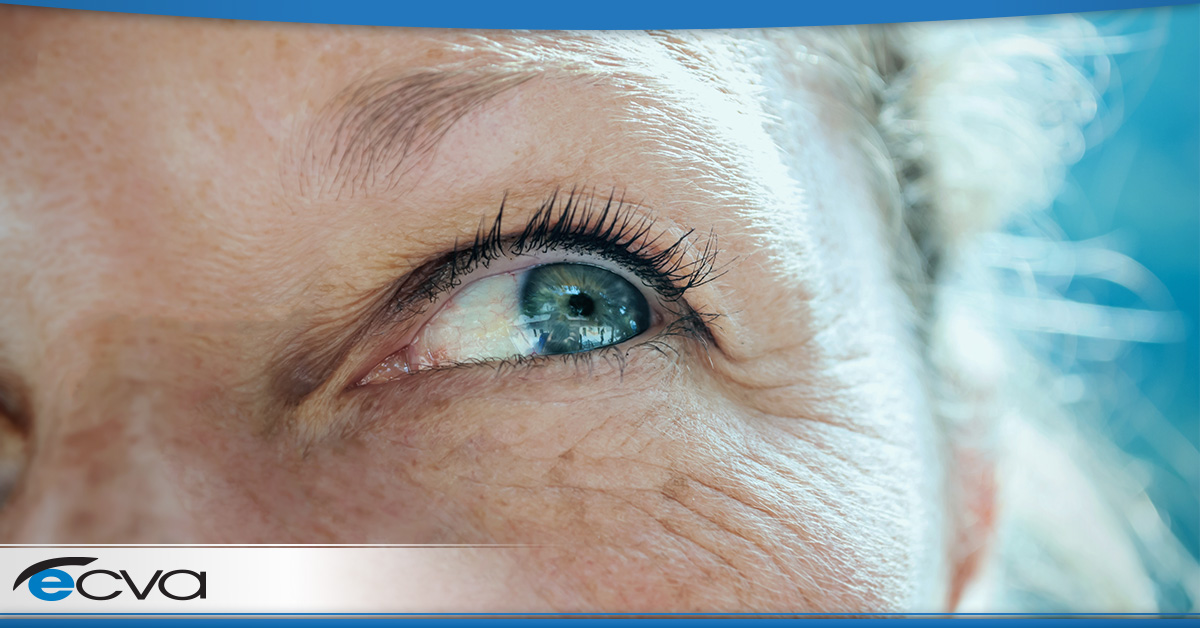If you live long enough, you may have laser-assisted cataract surgery. By age 80, 50% of Americans will likely have laser surgery for cataracts. Laser cataract surgery can restore vision when age-related cataracts threaten it.
Cataracts are the leading cause of blindness in the world. Cataracts cause blindness more than other common conditions like diabetic eye disease or macular degeneration. What is a cataract, and should you worry that you’re developing the condition?
A cataract occurs when the eye’s natural lens becomes cloudy, leading to a gradual loss of vision. The lens, usually clear and transparent, is located behind the iris (the colored part of the eye) and is responsible for focusing light onto the retina at the back of the eye. The retina then converts the light into electrical signals sent to the brain, allowing us to see. As a cataract develops, the clouding of the lens obstructs the passage of light, causing blurred vision, light sensitivity, faded colors, and eventually blindness.
Fortunately, cataracts are very slow to develop. Doctors can remove cataracts with safe and effective laser surgery. This article will help you understand everything you need to know about the procedure known as laser cataract surgery.
What is Laser Cataract Surgery?
Laser cataract surgery, or femtosecond laser-assisted cataract surgery (FLACS), is an advanced technique used to remove cataracts from the eye. Cataracts are a common age-related eye condition and cause the natural lens to become cloudy, leading to blurry vision and visual impairment.
In laser cataract surgery, a femtosecond laser performs the procedure. The laser creates precise incisions in the cornea, the transparent front part of the eye, and also performs the capsulotomy, where an opening is made in the front portion of the lens capsule. Additionally, the laser fragments the cataract-affected lens, facilitating its removal. These steps are followed by the extraction of the cloudy lens and the implantation of an artificial intraocular lens (IOL) to restore clear vision. Laser cataract surgery offers potential benefits of enhanced precision, reduced surgical complications, and faster recovery times, making it a promising option for certain patients. However, the choice of surgical method depends on individual circumstances and the surgeon’s expertise.
Who Performs Laser Surgery for Cataracts?
Ophthalmologists perform laser surgery for cataracts. Ophthalmologists are eye surgeons who specialize in cataract surgery, receiving specialized training in using femtosecond laser. These ophthalmologists are experienced in various aspects of cataract treatment and use the laser technology to enhance the precision and efficiency of the procedure. Laser cataract surgery is a highly specialized technique, and ophthalmologists must be well-versed in the intricacies of the equipment and its application. Patients can have confidence in the expertise of these skilled professionals, ensuring safe and effective outcomes for their vision correction needs.
Cataract Surgery Laser vs. Traditional
Whether laser or traditional cataract surgery is better is a topic of ongoing debate in ophthalmology. Both techniques have advantages and limitations, and the choice between them depends on various factors, including the patient’s specific needs and the surgeon’s experience and expertise. The most significant difference between laser cataract surgery and traditional is who makes the eye incisions. In conventional cataract surgery, your ophthalmologist makes the cuts by hand. During laser-assisted cataract surgery, the laser technology completes the incisions.
Here’s a balanced comparison of the two approaches:
Advantages of Laser Cataract Surgery
- Enhanced Precision: The femtosecond laser allows for more precise and customizable incisions, capsulotomies, and lens fragmentation, potentially leading to improved surgical outcomes.
- Reproducibility: Laser technology can offer consistent results, reducing the variability seen in manual cataract surgery.
- Astigmatism Correction: Laser-assisted incisions tailor to correct astigmatism, offering improved vision without glasses after surgery.
- Potential for Reduced Energy Usage: Laser fragmentation of the cataract can reduce the amount of ultrasound energy required during surgery, potentially leading to less stress on the eye’s tissues.
Advantages of Traditional Cataract Surgery (Phacoemulsification)
- Proven Track Record: Phacoemulsification has been the gold standard for cataract surgery for decades and has a well-established safety and success record.
- Surgeon Experience: Phacoemulsification is widely practiced, and experienced cataract surgeons have mastered the manual technique, achieving excellent outcomes.
- Versatility: Traditional cataract surgery can be adapted to handle various cataracts and is suitable for a wide range of patients.
- Cost: Traditional cataract surgery is generally more cost-effective than cataract surgery.
Perhaps surprisingly, the American Academy of Ophthalmology says, “Studies do not show that laser surgery results in fewer complications. Also, studies haven’t found that laser surgery provides better outcomes.” Ultimately, the “better” option between laser cataract surgery and traditional cataract surgery depends on individual patient needs and the specific cataract characteristics, and the surgeon’s experience. Some patients may benefit from the added precision and astigmatism correction potential of laser cataract surgery, while others may achieve equally successful results with traditional surgery at a lower cost.
Patients must have a detailed discussion with their ophthalmologist, considering all relevant factors, to make an informed decision about the most suitable approach for their cataract surgery. Both techniques can provide significant improvements in vision and quality of life for those with cataracts.
Surgeon Skill, Experience, and Precision
When facing a surgical procedure, the accuracy and precision of your surgeon always affect your healthcare outcome. In the case of laser or traditional cataract surgery, the American Academy of Ophthalmology says, “Your outcome depends in large part on the skill and experience of your surgeon.” The difference with laser-assisted cataract surgery is that the technology maps the eye structures allowing the surgeon to direct the machine with increased accuracy. The laser creates a precise 3-D image of the exact curve of the eye. Then, in seconds, the machine makes the incision exactly where it should. The laser also ends up softening the cataract for removal. Laser surgery is particularly beneficial for:
- Patients suffering from hard cataracts.
- Patients with astigmatism, which are irregularly shaped corneas.
- Patients seeking to replace their corneas with customized premium IOL devices to correct vision like contacts or glasses would.
- Difficult surgeries where incisions are challenging to create.
Procedure
In laser surgery for cataracts, a femtosecond laser performs the procedure. A femtosecond laser emits ultra-short light pulses. These lasers are high-speed and precise, making them valuable tools in various fields of science, medicine, and technology. allowing for safer, more accurate, and less invasive procedures than traditional methods.
Here’s how the cataract surgery process typically works:
- Corneal Incisions: The femtosecond laser creates precise incisions in the cornea, the clear front part of the eye. These incisions allow access to the cataract-affected lens.
- Capsulotomy: The laser precisely opens the front portion of the natural lens capsule. This step is essential because it allows the eye surgeon to access and remove the cataract without damaging the rest of the lens capsule, which will hold the new artificial intraocular lens in place.
- Lens Fragmentation: The laser breaks the cataract-affected lens into smaller, manageable fragments. This fragmentation allows for easier removal of the cloudy lens.
- Cataract Removal: After the laser prepares the lens, the surgeon removes the cataract fragments from the eye. This step is typically performed using ultrasound energy in a process called phacoemulsification.
- Intraocular Lens Implantation: Once the cataract is removed, an artificial intraocular lens is implanted into the lens capsule to replace the natural lens. The IOL serves to restore clear vision.
What are the Benefits of Laser Surgery for Cataracts?
Laser cataract surgery offers three benefits over traditional surgery. However, both laser-assisted and traditional cataract surgeries are safe and effective procedures. Deciding between the two techniques should be made based on individual patient characteristics, the surgeon’s expertise, and the availability of laser technology. Patients should consult their ophthalmologist to determine the most appropriate approach for their cataract surgery.
Benefit #1: Astigmatism Correction
One of the significant benefits of laser cataract surgery is its ability to correct astigmatism during the procedure. Astigmatism is a common refractive error caused by an irregularly shaped cornea, leading to distorted and blurred vision. In FLACS, the femtosecond laser can create precise incisions in the cornea that are customized to correct astigmatism. This targeted approach can reduce or eliminate astigmatism, providing patients with the potential for improved vision without the need for glasses or contact lenses after surgery. This aspect is particularly advantageous for individuals with cataracts and astigmatism, as it simultaneously addresses two vision issues.
Benefit #2: Reduced Risk of Complications
Laser cataract surgery can offer potential advantages in terms of safety and reduced risk of certain complications. The femtosecond laser’s accuracy allows for precise incisions, capsulotomies, and lens fragmentation, minimizing the possibility of human error during these critical steps. Additionally, the laser’s ability to create a consistent and well-centered capsulotomy can reduce the risk of complications related to the IOL’s placement, such as decentration or tilt. Moreover, the laser’s capability to pre-soften the cataract can reduce the amount of ultrasound energy required during lens removal, potentially leading to less stress on the eye’s delicate structures and a lower risk of thermal injury.
Benefit #3: Reduced Risk of Complications
The femtosecond laser’s ability to fragment the cataract-affected lens into smaller, more manageable pieces is another benefit of laser cataract surgery. This efficient lens fragmentation can make the subsequent removal process more precise. By reducing the amount of phacoemulsification energy needed to break up and remove the cataract, the procedure may be gentler on the eye, contributing to faster recovery times and improved patient comfort. Additionally, the reduced phacoemulsification time may lower the risk of endothelial cell damage, which is important for maintaining the cornea’s clarity.
What to Expect After Laser Cataract Surgery
After laser cataract surgery, patients can typically expect a straightforward and relatively quick recovery process. Some mild discomfort and blurry vision may occur in the immediate postoperative period, but this usually subsides within a day or two. Most individuals experience improved vision within the first week, but recovery may take a few weeks. It’s essential to follow the postoperative instructions provided by the surgeon, which may include using prescribed eye drops, avoiding strenuous activities, and protecting the eyes from bright lights or potential sources of infection. Your clinical team will schedule regular follow-up appointments to monitor progress and ensure optimal healing.
How Much Does Laser Cataract Surgery Cost?
Laser-assisted cataract surgery can cost $3,500 to $7,000 per eye. The price varies by the type of IOL you use, where you live, and if you have insurance, whether the doctor is in-network or out. Generally, major health insurers do cover cataract surgery. How much and what they cover varies by the carrier. Medicare typically covers about 80% of the cataract removal procedure. You can use your health savings accounts (HSAs) and flexible spending accounts (FSAs) to pay for your surgery.
Is Laser Surgery for Cataracts Right for You? Consult the Experts at ECVA
Eye Care & Vision Associates (ECVA) is one of the top cataract surgeons in Williamsville, Orchard Park, Niagara Falls, and Buffalo, New York. Talk with our team today about how laser-assisted cataract surgery can help restore your vision and get your life back.











